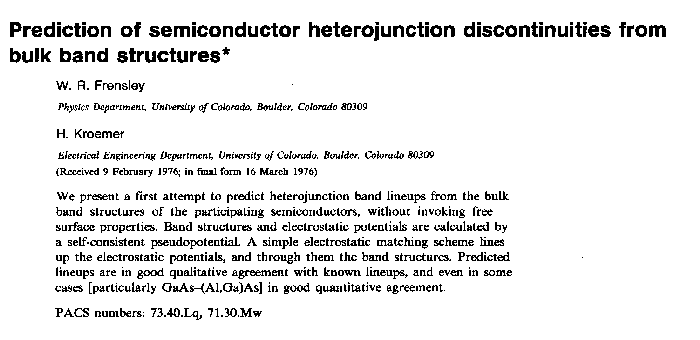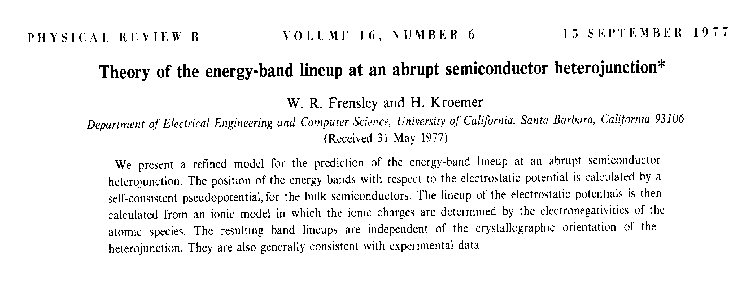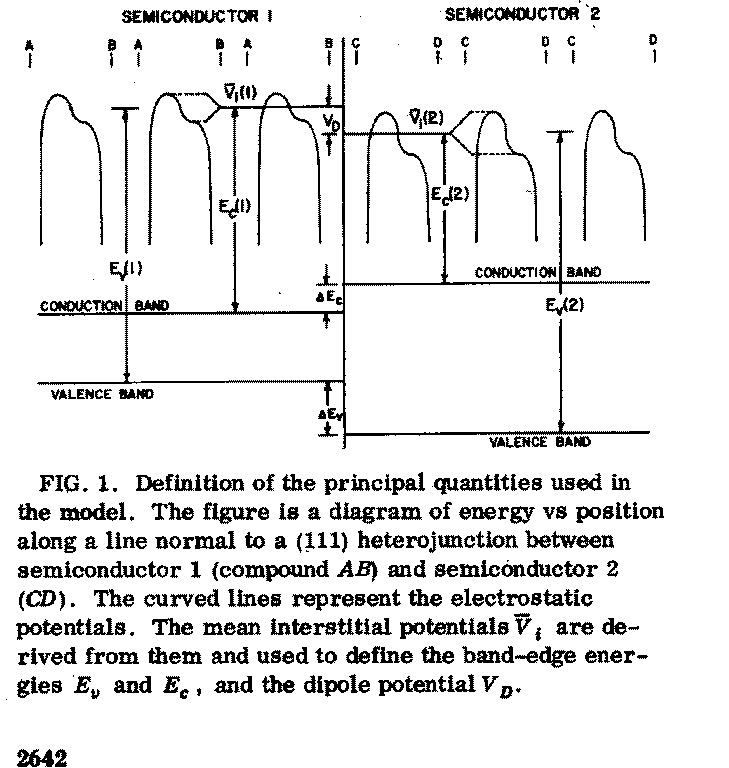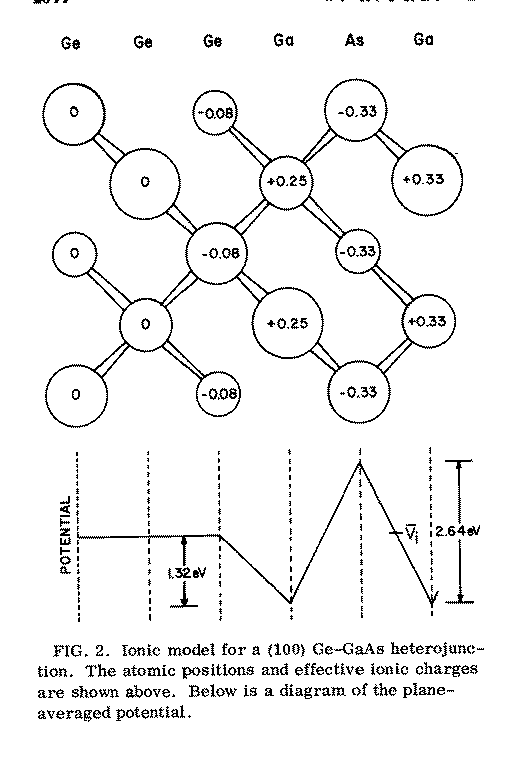
A semiconductor heterojunction is a junction between two chemically different semiconductors, such as a junction between germanium and gallium arsenide. (Click here to see a review of heterostructure physics.) At such a junction, the energy band gap of the semiconductors must change abruptly. How much of the change occurs in the conduction band and how much occurs in the valence band determines the band alignment of the heterojunction.
In 1974, semiconductor heterostructure technology was, by today's standards, almost nonexistent. Shockley had included the concept of a heterojunction emitter as a claim in the bipolar transistor patent, and Herb Kroemer (at that time, Krömer) had proposed a number of heterojunction device concepts in the late 1950's and early 1960's. R. L. Anderson had investigated heterojunctions by 1962, and presented a model for the band alignment based upon the experimentally measured electron affinities of the participating semiconductors R.L. Anderson, Solid-State Electronics 5, 341 [1962]. Experimental investigations of heterojunctions had been carried out through the 1960's primarily by Arthur Milnes and his students at Carnegie, and by Alferov in the Soviet Union. I began working for Herb Kroemer on the problem of theoretically predicting heterojunction band alignments just as heterojunction technology entered its phase of explosive development. This development can be traced primarily to the perfection of molecular beam epitaxy technology, by A. Y. Cho and co-workers. The potential of this technology really became apparent with the fabrication and experimental verification of quantum wells: R. Dingle, A.C. Gossard, and W. Wiegmann, Physical Review Letters 34, 1327 [1975]. Also acitve at this time was a group at IBM lead by L. Esaki and L. L. Chang.
The initial results of our theory were published in 1976, W. R. Frensley and H. Kroemer, Journal of Vacuum Science and Technology 13, 810-5 [1976]. The title and abstract are reproduced below. One year later, Walter Harrison published an approach to the heterojunction alignment problem based upon a tight-binding band structure model: W.A. Harrison, J. Vac. Sci. Technol. 14, 1016 [1977].

The more complete paper, including a refined set of calculations and a more thorough examination of the rationale of the approach, was W. R. Frensley and H. Kroemer, Physical Review B 16, 2642-52 [1977].

The fundamental approach of the theory is illustrated below. We divided the problem into two components: (1) determining the location of the energy-band edges with respect to the local periodic electrostatic potential within the crystal and (2) determining how the periodic potentials line up across a junction. For (1) we used a self-consistent pseuodpotential model and for (2) we used simple spherical ion model of the crystal charge distribution.

The following figure illustrates the ionic model of the charge disribution.

Heterojunction alignment theories of comparable complexity became a very popular pursuit in the mid- to late-1980's. At the same time, more detailed microscopic calculations were done. The Frensley and Kroemer Phys. Rev. paper is seldom read today, but in terms of the conceptual framework for the study of the alignment problem, and the understanding of the effects which bear upon the results, it has hardly been superceded by subsequent work.
The overall approach to this work was simply that Herb Kroemer identified an outstanding problem (predicting heterojunction band alignments), and we set out to solve it by adapting whatever material was required. This involved implementing pseudopotential band structure codes from scratch, and also investigating and coding several other techniques (such as dielectric-function matching schemes) that did not make it into the final theory. None of these techniques were in Kroemer's domain of specialty. I have come to realize that this was a rather atypical experience for Ph.D. research. More typically, a student learns the techniques of which his advisor is the master, and then necessarily becomes an advocate of those techniques due to the effort he has invested. What I learned from Herb Kroemer was that you can master, reproduce (in the form of computer code) and contrubute to, any threortical techniques that others have developed. Therefore, pick the best technique for whatever problem you encounter. In short, one should be problem-driven, not expertise-driven.